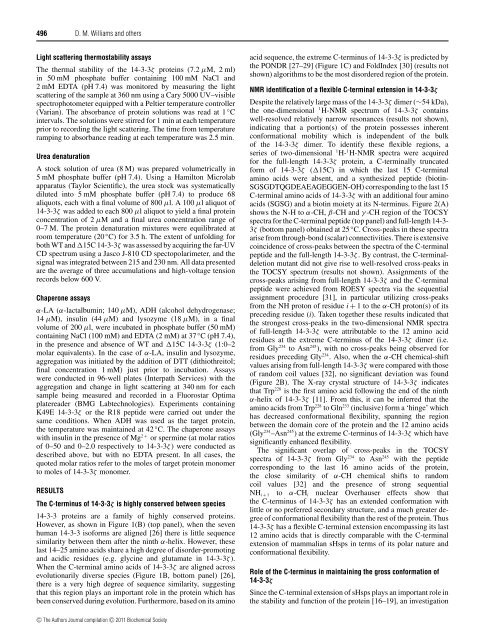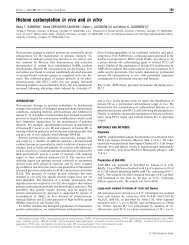Full Text PDF - Biochemical Journal
Full Text PDF - Biochemical Journal
Full Text PDF - Biochemical Journal
You also want an ePaper? Increase the reach of your titles
YUMPU automatically turns print PDFs into web optimized ePapers that Google loves.
496 D. M. Williams and othersLight scattering thermostability assaysThe thermal stability of the 14-3-3ζ proteins (7.2 μM, 2 ml)in 50 mM phosphate buffer containing 100 mM NaCl and2 mM EDTA (pH 7.4) was monitored by measuring the lightscattering of the sample at 360 nm using a Cary 5000 UV–visiblespectrophotometer equipped with a Peltier temperature controller(Varian). The absorbance of protein solutions was read at 1 ◦ Cintervals. The solutions were stirred for 1 min at each temperatureprior to recording the light scattering. The time from temperatureramping to absorbance reading at each temperature was 2.5 min.Urea denaturationA stock solution of urea (8 M) was prepared volumetrically in5 mM phosphate buffer (pH 7.4). Using a Hamilton Microlabapparatus (Taylor Scientific), the urea stock was systematicallydiluted into 5 mM phosphate buffer (pH 7.4) to produce 68aliquots, each with a final volume of 800 μl. A 100 μl aliquot of14-3-3ζ was added to each 800 μl aliquot to yield a final proteinconcentration of 2 μM and a final urea concentration range of0–7 M. The protein denaturation mixtures were equilibrated atroom temperature (20 ◦ C) for 3.5 h. The extent of unfolding forboth WT and 15C 14-3-3ζ was assessed by acquiring the far-UVCD spectrum using a Jasco J-810 CD spectopolarimeter, and thesignal was integrated between 215 and 230 nm. All data presentedare the average of three accumulations and high-voltage tensionrecords below 600 V.Chaperone assaysα-LA (α-lactalbumin; 140 μM), ADH (alcohol dehydrogenase;14 μM), insulin (44 μM) and lysozyme (18 μM), in a finalvolume of 200 μl, were incubated in phosphate buffer (50 mM)containing NaCl (100 mM) and EDTA (2 mM) at 37 ◦ C (pH 7.4),in the presence and absence of WT and 15C 14-3-3ζ (1:0–2molar equivalents). In the case of α-LA, insulin and lysozyme,aggregation was initiated by the addition of DTT (dithiothreitol;final concentration 1 mM) just prior to incubation. Assayswere conducted in 96-well plates (Interpath Services) with theaggregation and change in light scattering at 340 nm for eachsample being measured and recorded in a Fluorostar Optimaplatereader (BMG Labtechnologies). Experiments containingK49E 14-3-3ζ or the R18 peptide were carried out under thesame conditions. When ADH was used as the target protein,the temperature was maintained at 42 ◦ C. The chaperone assayswith insulin in the presence of Mg 2 + or spermine (at molar ratiosof 0–50 and 0–2.0 respectively to 14-3-3ζ ) were conducted asdescribed above, but with no EDTA present. In all cases, thequoted molar ratios refer to the moles of target protein monomerto moles of 14-3-3ζ monomer.RESULTSThe C-terminus of 14-3-3ζ is highly conserved between species14-3-3 proteins are a family of highly conserved proteins.However, as shown in Figure 1(B) (top panel), when the sevenhuman 14-3-3 isoforms are aligned [26] there is little sequencesimilarity between them after the ninth α-helix.However,theselast 14–25 amino acids share a high degree of disorder-promotingand acidic residues (e.g. glycine and glutamate in 14-3-3ζ ).When the C-terminal amino acids of 14-3-3ζ are aligned acrossevolutionarily diverse species (Figure 1B, bottom panel) [26],there is a very high degree of sequence similarity, suggestingthat this region plays an important role in the protein which hasbeen conserved during evolution. Furthermore, based on its aminoacid sequence, the extreme C-terminus of 14-3-3ζ is predicted bythe PONDR [27–29] (Figure 1C) and FoldIndex [30] (results notshown) algorithms to be the most disordered region of the protein.NMR identification of a flexible C-terminal extension in 14-3-3ζDespite the relatively large mass of the 14-3-3ζ dimer (∼54 kDa),the one-dimensional 1 H-NMR spectrum of 14-3-3ζ containswell-resolved relatively narrow resonances (results not shown),indicating that a portion(s) of the protein possesses inherentconformational mobility which is independent of the bulkof the 14-3-3ζ dimer. To identify these flexible regions, aseries of two-dimensional 1 H- 1 H-NMR spectra were acquiredfor the full-length 14-3-3ζ protein, a C-terminally truncatedform of 14-3-3ζ (15C) in which the last 15 C-terminalamino acids were absent, and a synthesized peptide (biotin-SGSGDTQGDEAEAGEGGEN-OH) corresponding to the last 15C-terminal amino acids of 14-3-3ζ with an additional four aminoacids (SGSG) and a biotin moiety at its N-terminus. Figure 2(A)shows the N-H to α-CH, β-CH and γ -CH region of the TOCSYspectra for the C-terminal peptide (top panel) and full-length 14-3-3ζ (bottom panel) obtained at 25 ◦ C. Cross-peaks in these spectraarise from through-bond (scalar) connectivities. There is extensivecoincidence of cross-peaks between the spectra of the C-terminalpeptide and the full-length 14-3-3ζ . By contrast, the C-terminaldeletionmutant did not give rise to well-resolved cross-peaks inthe TOCSY spectrum (results not shown). Assignments of thecross-peaks arising from full-length 14-3-3ζ and the C-terminalpeptide were achieved from ROESY spectra via the sequentialassignment procedure [31], in particular utilizing cross-peaksfrom the NH proton of residue i + 1totheα-CH proton(s) of itspreceding residue (i). Taken together these results indicated thatthe strongest cross-peaks in the two-dimensional NMR spectraof full-length 14-3-3ζ were attributable to the 12 amino acidresidues at the extreme C-terminus of the 14-3-3ζ dimer (i.e.from Gly 234 to Asn 245 ), with no cross-peaks being observed forresidues preceding Gly 234 . Also, when the α-CH chemical-shiftvalues arising from full-length 14-3-3ζ were compared with thoseof random coil values [32], no significant deviation was found(Figure 2B). The X-ray crystal structure of 14-3-3ζ indicatesthat Trp 228 is the first amino acid following the end of the ninthα-helix of 14-3-3ζ [11]. From this, it can be inferred that theamino acids from Trp 228 to Gln 233 (inclusive) form a ‘hinge’ whichhas decreased conformational flexibility, spanning the regionbetween the domain core of the protein and the 12 amino acids(Gly 234 –Asn 245 ) at the extreme C-terminus of 14-3-3ζ which havesignificantly enhanced flexibility.The significant overlap of cross-peaks in the TOCSYspectra of 14-3-3ζ from Gly 234 to Asn 245 with the peptidecorresponding to the last 16 amino acids of the protein,the close similarity of α-CH chemical shifts to randomcoil values [32] and the presence of strong sequentialNH i + 1 to α-CH i nuclear Overhauser effects show thatthe C-terminus of 14-3-3ζ has an extended conformation withlittle or no preferred secondary structure, and a much greater degreeof conformational flexibility than the rest of the protein. Thus14-3-3ζ has a flexible C-terminal extension encompassing its last12 amino acids that is directly comparable with the C-terminalextension of mammalian sHsps in terms of its polar nature andconformational flexibility.Role of the C-terminus in maintaining the gross conformation of14-3-3ζSince the C-terminal extension of sHsps plays an important role inthe stability and function of the protein [16–19], an investigationc○ The Authors <strong>Journal</strong> compilation c○ 2011 <strong>Biochemical</strong> Society








